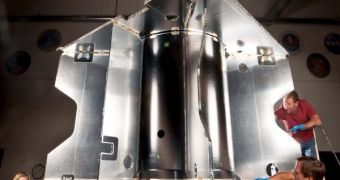Lockheed Martin engineering teams working on the NASA Mars Atmosphere and Volatile EvolutioN (MAVEN) spacecraft announce that the primary structure has already been completed. The teams are now ready to move on to the next step in the assembly phase of the project.
This remarkable milestone was achieved on schedule, at the Lockheed Space Systems Company facility near Denver, Colorado. With this achievement, the mission remains on track to a launch date set between November 18 and December 7, 2013.
MAVEN's primary mission will be to study and understand the upper atmosphere surrounding Mars. It will also play a significant role in tracking down and identifying the sources of methane that continuously replace the gas in the air above Mars.
It will also investigate how the loss of chemicals from the air affected the planet and its atmosphere over millions of years. In addition, the orbiter will carry instruments uniquely equipped to analyze the interactions between solar winds and the thin atmosphere surrounding the Red planet.
University of Colorado in Boulder (UCB) Laboratory for Atmospheric and Space Physics (LASP) professor Bruce Jakosky is the principal investigator of the mission. The University of California in Berkeley (UCB) and the NASA Goddard Space Flight Center are also major contractors.
“It’s always a significant milestone when the project moves from a paper design to real hardware and software,” explains the Lockheed SSC MAVEN program manager, Guy Beutelschies. He is in charge with most of the aspect related to the orbiter's construction.
“Seeing the core structure really reinforces the fact that MAVEN is no longer just a set of ideas that scientists and engineers have come up with, it is starting to become a spacecraft,” the official adds.
The primary structure is shaped almost like a cube, measuring 7.5 feet x 7.5 feet x 6.5 feet high (2.3 meters x 2.3 meters x 2 meters high). According to NASA specifications, the entire structure only weighs 125 kilograms (275 pounds).
“Built out of composite panels comprised of aluminum honeycomb sandwiched between graphite composite face sheets and attached to one another with metal fittings,” a NASA press release explains.
“At the center of the structure is the 4.25 feet (1.3 meters) diameter core cylinder that encloses the hydrazine propellant tank and serves as the primary vertical load-bearing structure. The large tank will hold approximately 3,615 pounds (1640 kilograms) of fuel,” the statement concludes.
The GSFC, in Greenbelt, Maryland, manages MAVEN for the NASA Science Mission Directorate at the space agency's Headquarters, in Washington, DC.

 14 DAY TRIAL //
14 DAY TRIAL //